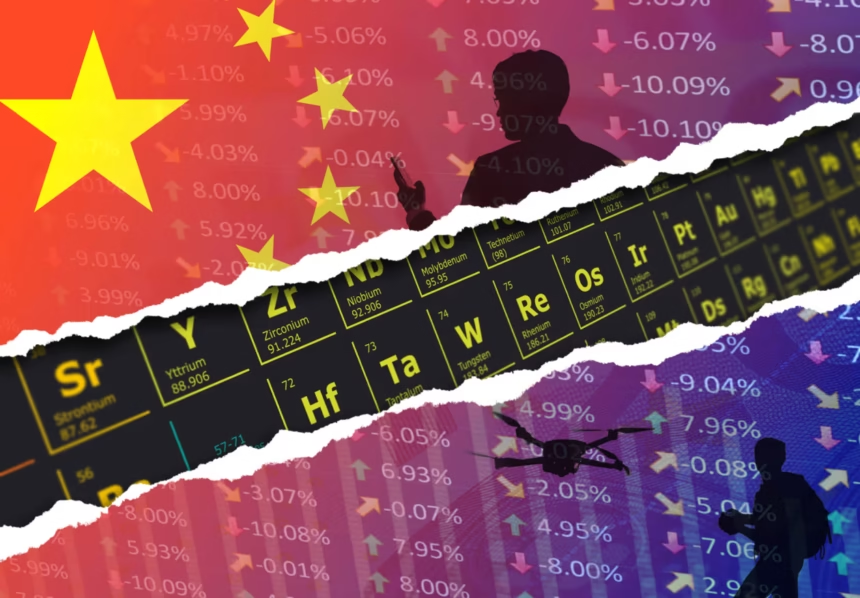BANGKOK – China’s control over the global rare earth supply is tightening, as new reports say the government is targeting foreign businesses trying to build up reserves of these key materials. This latest move, seen as a calculated answer in the ongoing trade dispute, highlights China’s near-total control over rare earth elements (REEs).
These minerals are essential for everything from mobile phones to military aircraft. But the true cost of this power is becoming hard to ignore, with serious environmental damage in parts of Myanmar and long-standing claims of poor labour practices casting a long shadow over China’s rare earth industry.
Warning Shots to Overseas Businesses
China has made it clear: foreign companies face penalties if they try to accumulate large rare earth stocks. Messages shared on X show that Beijing is keen to keep its power intact by blocking outsiders from building up dangerous stock levels of minerals needed for high-tech goods and modern defence.
This comes after China’s decision in April 2025 to impose export restrictions on seven rare earths and permanent magnets, in what many see as a reaction to steep US import taxes on Chinese products. These limits are already causing headaches for global supply chains, prompting firms like Ford to cut back manufacturing and sending rare earth prices soaring.
Experts think China’s actions go far beyond simple economics. “Beijing is using rare earths as both a warning and a reward in global politics,” explained Gabriel Wildau of Teneo. With no rare earth futures market and strict controls over trading in key cities like Baotou and Ganzhou, China sets the rules. Western businesses are left scrambling to keep up.
The Scale of China’s Rare Earth Monopoly
China’s grip over the rare earth sector is almost complete. The country is behind an estimated 70% of global mining and 90% of refining, overseeing the entire process from extraction right through to finished magnets for electric cars, wind farms, and military tech.
This control is the result of years of calculated investment. Back in the 1980s, China used lower labour costs and weaker environmental laws to compete with Western firms. By the 1990s, America’s Mountain Pass mine, once a powerhouse, was sending ore to China for processing—a situation that still holds.
To tighten its hold, China has merged hundreds of small-scale miners into two vast state-run enterprises: China Rare Earth Group and China Northern Rare Earth Group High-Tech.
These groups now set output targets and prices and manage exports, giving Beijing unmatched influence. In 2024, China produced 270,000 metric tonnes of rare earth oxides, far outpacing America’s 45,000 tonnes.
China’s efforts extend outside its borders. In Myanmar’s Kachin and Shan states, Chinese-linked outfits and local militias run rare earth mines. These sites have left whole regions contaminated.
Toxic chemicals used in methods banned in many countries are poisoning rivers and farmland, forcing local people to live with dirty water and dead crops. Myanmar’s lawless mining zones make things worse, giving China cover to shift much of the pollution outside its borders.
Within China, the Baotou tailings lake stands as proof of the toll. Here, a massive pool of sludge mixed with radioactive waste sits close to people’s homes, linked with rising cancer rates and polluted groundwater.
Critics say China’s willingness to accept such harm gives it a cost edge over Western countries that face much tighter rules.
Worries over Working Conditions
Concerns about how rare earths are sourced do not stop with the environment. Steady reports from Myanmar point to unsafe mining, with children and forced labour sometimes involved. These claims are tough to confirm due to limited access, but they make ethical risks even clearer for Western companies stuck relying on Chinese REEs.
Back in China, the rapid expansion of rare earth mining during the 1990s and 2000s led to hazardous working conditions. Although the government has since put stricter rules in place, critics argue these changes are more about saving resources than fixing human rights problems for workers.
Western countries are starting to recognize how much they rely on China’s rare earth sector. The US is injecting cash into the revival of Mountain Pass and new processing projects like Lynas Rare Earths’ site in Texas, aiming to handle rare earths such as dysprosium and terbium.
Europe is investing in facilities in Estonia and France, but these are not expected to be fully operational before 2026.
There is a long road ahead. Building a rare earth industry from scratch needs huge sums of money, careful planning, and approval under strict environmental laws—barriers China avoids. “China’s single-process system from mining to magnets is almost impossible to copy,” said Alberto Prina Cerai from Italy’s Institute for International Political Studies.
Even countries with larger reserves, like Australia and Brazil, lack the needed refining capacity. China remains in command of the world’s rare earths thanks to its centralized strategy, but its gains come with heavy social and environmental damage in Myanmar and at home.
Widespread claims of poor working conditions add to the picture of a country putting profits and power first. As China increases pressure on foreign businesses and holds tight to export controls, the West must either invest in its supply lines or face future shortages.
At the moment, the fate of advanced industries around the world hangs in the balance. China’s key role in rare earths means other nations will need years to catch up, if they can catch up at all. As one industry source put it, until Western countries build their rare earth chains, China is firmly in the driving seat and well aware of it.














